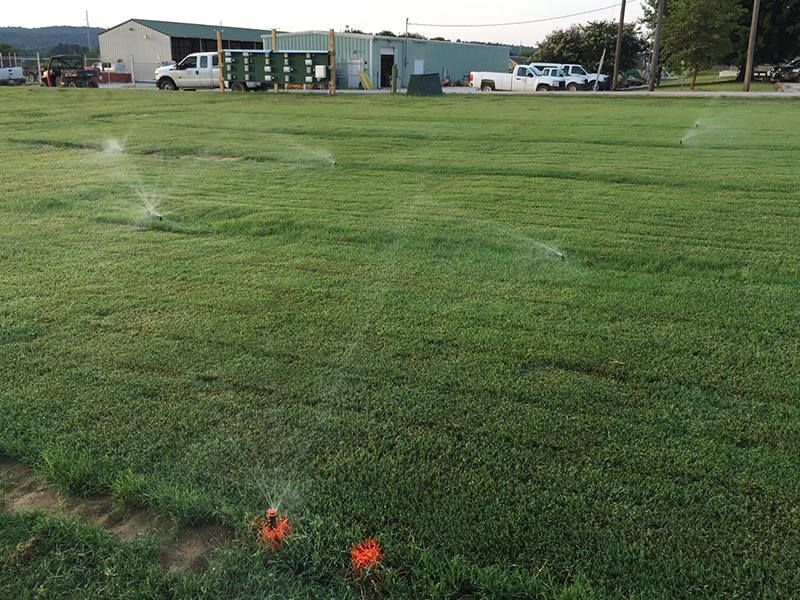Rain, soil moisture sensors can save water, money, while supporting healthy lawn
The sensor technologies are fairly easy to set up, either by an irrigation company or a homeowner. However, the most important component to any irrigation system that uses soil moisture sensors is knowledge of best lawn-management practices.
Aug. 9, 2022
By Mary Hightower
U of A System Division of Agriculture
Fast facts
- Three-year study shows significant savings with sensor use
- Sensors can aid water conservation efforts
(490 words)
(Newsrooms: with art https://flic.kr/s/aHBqjA2EAY )
FAYETTEVILLE, Ark. — Using rain and soil moisture sensors with an automated home irrigation system can save water, money and still support a healthy lawn, according to a three-year study conducted within the Arkansas Agricultural Experiment Station
“The current drought in Arkansas is a good reminder that we can’t take water for granted,” said Mike Richardson, professor-turfgrass, for the University of Arkansas System Division of Agriculture. “This work demonstrates the cost savings in water and the return on investment of various sensors that can be added to lawn irrigation systems.”
Dan Sandor, now an assistant professor-turfgrass science at Virginia Tech, conducted the research as part of his Ph.D. work at the University of Arkansas.

“The rain sensors tell you whether it’s raining or not,” Sandor said. “The nice thing about the soil moisture sensor is it’s actually measuring how much water is available to the lawn.”
The research, conducted on bermudagrass turf, found that the use of rain sensors and soil moisture sensors reduced water use by 22.1 percent and 66.2 percent, respectively. In terms of dollars, the rain sensors saved $87 in the first year, while the soil moisture sensor saved $200 in the first year.
Sensor differences
Rain sensors monitor whether rainfall has occurred at the time irrigation is scheduled to run and will bypass watering cycles as a result of recent precipitation,” Sandor said. “The great thing about the soil moisture sensors is it’s actually measuring how much water is present within the root zone of the soil and prevents unnecessary watering when sufficient moisture is available to the turf.”
The researchers note that the actual return on investment would depend on factors including local water utility costs, irrigation schedule, lawn size and soil texture. While the turf was managed in a research setting, it was cared for in a way that any homeowner, using a Cooperative Extension Service fact sheet could do, Sandor said.
Education is key
The sensor technologies are fairly easy to set up, either by an irrigation company or a homeowner. However, the most important component to any irrigation system that uses soil moisture sensors is knowledge of best lawn-management practices, Sandor said.
“Research shows that people won’t use them long-term without education,” he said. “At the end of the day, to get the return on your investment, you’ve got to have discipline in following university-extension recommended best management practices for lawncare.”
The researchers said that “it remains critical to continue educating homeowners on lawn irrigation best management practices and encouraging them to adopt improved sensor technologies so they can enjoy a high-quality lawn while saving money and positively contributing to water conservation efforts.”
The research was published in the June 2022 edition of the journal “Crop, Forage and Turfgrass Management.” Working with Sandor and Richardson on this research was Douglas Karcher, now department chair of Horticulture and Crop Science at The Ohio State University. At the time, Karcher was interim assistant director of the Arkansas Agricultural Experiment Station.
To learn more about Division of Agriculture research, visit the Arkansas Agricultural Experiment Station website: https://aaes.uada.edu. Follow on Twitter at @ArkAgResearch. To learn more about the Division of Agriculture, visit https://uada.edu/. Follow us on Twitter at @AgInArk. To learn about extension programs in Arkansas, contact your local Cooperative Extension Service agent or visit www.uaex.uada.edu.
About the Division of Agriculture
The University of Arkansas System Division of Agriculture’s mission is to strengthen agriculture, communities, and families by connecting trusted research to the adoption of best practices. Through the Agricultural Experiment Station and the Cooperative Extension Service, the Division of Agriculture conducts research and extension work within the nation’s historic land grant education system.
The Division of Agriculture is one of 20 entities within the University of Arkansas System. It has offices in all 75 counties in Arkansas and faculty on five system campuses.
Pursuant to 7 CFR § 15.3, the University of Arkansas System Division of Agriculture offers all its Extension and Research programs and services (including employment) without regard to race, color, sex, national origin, religion, age, disability, marital or veteran status, genetic information, sexual preference, pregnancy or any other legally protected status, and is an equal opportunity institution.
# # #
Media contact: Mary Hightower mhightower@uada.edu